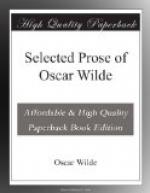THE ART OF ARCHAEOLOGY
Indeed archaeology is only really delightful when transfused into some form of art. I have no desire to underrate the services of laborious scholars, but I feel that the use Keats made of Lempriere’s Dictionary is of far more value to us than Professor Max Muller’s treatment of the same mythology as a disease of language. Better Endymion than any theory, however sound, or, as in the present instance, unsound, of an epidemic among adjectives! And who does not feel that the chief glory of Piranesi’s book on Vases is that it gave Keats the suggestion for his ‘Ode on a Grecian Urn’? Art, and art only, can make archaeology beautiful; and the theatric art can use it most directly and most vividly, for it can combine in one exquisite presentation the illusion of actual life with the wonder of the unreal world. But the sixteenth century was not merely the age of Vitruvius; it was the age of Vecellio also. Every nation seems suddenly to have become interested in the dress of its neighbours. Europe began to investigate its own clothes, and the amount of books published on national costumes is quite extraordinary. At the beginning of the century the Nuremberg Chronicle, with its two thousand illustrations, reached its fifth edition, and before the century was over seventeen editions were published of Munster’s Cosmography. Besides these two books there were also the works of Michael Colyns, of Hans Weigel, of Amman, and of Vecellio himself, all of them well illustrated, some of the drawings in Vecellio being probably from the hand of Titian.
Nor was it merely from books and treatises that they acquired their knowledge. The development of the habit of foreign travel, the increased commercial intercourse between countries, and the frequency of diplomatic missions, gave every nation many opportunities of studying the various forms of contemporary dress. After the departure from England, for instance, of the ambassadors from the Czar, the Sultan and the Prince of Morocco, Henry the Eighth and his friends gave several masques in the strange attire of their visitors. Later on London saw, perhaps too often, the sombre splendour of the Spanish Court, and to Elizabeth came envoys from all lands, whose dress, Shakespeare tells us, had an important influence on English costume.—The Truth of Masks.




